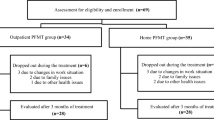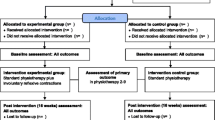Abstract
Purpose
Supervised pelvic floor muscle training in patients of stress and mixed urinary incontinence has been recommended. Our aim was to assess the utilisation and effectiveness of our supervised pelvic floor muscle training service and assess the impact of incontinence scores before physiotherapy on the subsequent results of physiotherapy.
Methods
All 271 patients referred to physiotherapy for symptoms of incontinence filled out the International Consultation on Incontinence Modular Questionnaire-Female Lower Urinary Tract Symptoms before starting treatment. Depending on pelvic floor muscle assessment, plans for exercises and follow up were made. If the strength of pelvic floor muscles was poor, electrical stimulation was offered. If awareness of the pelvic floor muscle contraction was poor, bio feedback was offered. Group sessions and vaginal cones were also used. Depending on the response to the treatment; patients were either discharged, referred to Urogynaecology clinic or continued physiotherapy. All patients who were discharged or referred for surgery were given a post treatment questionnaire to fill out.
Results
79 (56 %) of 132 women with stress, 49 (51 %) of 98 with mixed and 27 (66 %) of 41 with urge incontinence reported successful control of symptoms (overall success 54 %). However, 65 % of women with incontinence scores of 0–5 before physiotherapy, 64 % with 6–10, 42 % with 11–15 and mere 28 % with 16–20 achieved success with physiotherapy. 27 (10 %) were lost to follow up.
Conclusion
1 in 2 women referred to physiotherapy for incontinence, achieved successful control of symptoms without the need for invasive investigations or surgery. However, poor incontinence scores before the start of physiotherapy is a poor prognostic indicator for success. 90 % women utilised the service.











Similar content being viewed by others
References
Milsom I (2009) Lower urinary tract symptoms in women. Curr Opin Urol 19(4):337–341
National Institute of Health and Care Excellence Guideline (2013) The management of urinary incontinence in women
Hay-Smith EJ, Herderschee R, Dumoulin C, Herbison GP (2011) Comparisons of approaches to pelvic floor muscle training for urinary incontinence in women. Cochrane Database Syst Rev. doi:10.1002/14651858.CD009508
Hendricks EJM et al (2009) Prognostic indicators of poor short term outcome of physiotherapy intervention in women with stress urinary incontinence. Neurol Urodyn 29(3):336–343
Author information
Authors and Affiliations
Corresponding author
Ethics declarations
Conflict of interest
No conflict of interest to declare.
Rights and permissions
About this article
Cite this article
Singh, N., Rashid, M., Bayliss, L. et al. Pelvic floor muscle training for female urinary incontinence: Does it work?. Arch Gynecol Obstet 293, 1263–1269 (2016). https://doi.org/10.1007/s00404-015-3965-x
Received:
Accepted:
Published:
Issue Date:
DOI: https://doi.org/10.1007/s00404-015-3965-x




